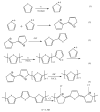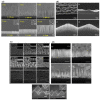π-Conjugated Polymers and Their Application in Organic and Hybrid Organic-Silicon Solar Cells
- PMID: 35215629
- PMCID: PMC8877693
- DOI: 10.3390/polym14040716
π-Conjugated Polymers and Their Application in Organic and Hybrid Organic-Silicon Solar Cells
Abstract
The evolution and emergence of organic solar cells and hybrid organic-silicon heterojunction solar cells have been deemed as promising sustainable future technologies, owing to the use of π-conjugated polymers. In this regard, the scope of this review article presents a comprehensive summary of the applications of π-conjugated polymers as hole transporting layers (HTLs) or emitters in both organic solar cells and organic-silicon hybrid heterojunction solar cells. The different techniques used to synthesize these polymers are discussed in detail, including their electronic band structure and doping mechanisms. The general architecture and principle of operating heterojunction solar cells is addressed. In both discussed solar cell types, incorporation of π-conjugated polymers as HTLs have seen a dramatic increase in efficiencies attained by these devices, owing to the high transmittance in the visible to near-infrared region, reduced carrier recombination, high conductivity, and high hole mobilities possessed by the p-type polymeric materials. However, these cells suffer from long-term stability due to photo-oxidation and parasitic absorptions at the anode interface that results in total degradation of the polymeric p-type materials. Although great progress has been seen in the incorporation of conjugated polymers in the various solar cell types, there is still a long way to go for cells incorporating polymeric materials to realize commercialization and large-scale industrial production due to the shortcomings in the stability of the polymers. This review therefore discusses the progress in using polymeric materials as HTLs in organic solar cells and hybrid organic-silicon heterojunction solar cells with the intention to provide insight on the quest of producing highly efficient but less expensive solar cells.
Keywords: heterojunction solar cell; hole transporting layer; n- and p-type doping; organic photovoltaic cell; π-conjugated polymer.
Conflict of interest statement
The authors declare no conflict of interest.
Figures























Similar articles
-
A Mini Review on the Development of Conjugated Polymers: Steps towards the Commercialization of Organic Solar Cells.Polymers (Basel). 2022 Dec 29;15(1):164. doi: 10.3390/polym15010164. Polymers (Basel). 2022. PMID: 36616512 Free PMC article. Review.
-
Conducting Polymers for Optoelectronic Devices and Organic Solar Cells: A Review.Polymers (Basel). 2020 Nov 9;12(11):2627. doi: 10.3390/polym12112627. Polymers (Basel). 2020. PMID: 33182241 Free PMC article. Review.
-
Recent Advances in Hole-Transporting Layers for Organic Solar Cells.Nanomaterials (Basel). 2022 Jan 28;12(3):443. doi: 10.3390/nano12030443. Nanomaterials (Basel). 2022. PMID: 35159788 Free PMC article. Review.
-
Naphthalene Diimide-Based n-Type Polymers: Efficient Rear Interlayers for High-Performance Silicon-Organic Heterojunction Solar Cells.ACS Nano. 2017 Jul 25;11(7):7215-7222. doi: 10.1021/acsnano.7b03090. Epub 2017 Jul 11. ACS Nano. 2017. PMID: 28679036
-
Conductive conjugated polyelectrolyte as hole-transporting layer for organic bulk heterojunction solar cells.Adv Mater. 2014 Feb;26(5):780-5. doi: 10.1002/adma.201302845. Epub 2013 Oct 30. Adv Mater. 2014. PMID: 24170587
Cited by
-
Nanotechnology for brain tumor imaging and therapy based on π-conjugated materials: state-of-the-art advances and prospects.Front Chem. 2023 Nov 8;11:1301496. doi: 10.3389/fchem.2023.1301496. eCollection 2023. Front Chem. 2023. PMID: 38025074 Free PMC article. Review.
-
DNA as a perfect quantum computer based on the quantum physics principles.Sci Rep. 2024 May 21;14(1):11636. doi: 10.1038/s41598-024-62539-5. Sci Rep. 2024. PMID: 38773193 Free PMC article.
-
Microscopic, Spectroscopic, and Electrochemical Characterization of Novel Semicrystalline Poly(3-hexylthiophene)-Based Dendritic Star Copolymer.Polymers (Basel). 2022 Oct 18;14(20):4400. doi: 10.3390/polym14204400. Polymers (Basel). 2022. PMID: 36297982 Free PMC article.
-
Gold Nanoparticles Modulate Excimer and Exciplex Dynamics of PDDCP-Conjugated Polymers.Polymers (Basel). 2024 Aug 26;16(17):2420. doi: 10.3390/polym16172420. Polymers (Basel). 2024. PMID: 39274052 Free PMC article.
-
Literature Review on Conjugated Polymers as Light-Sensitive Materials for Photovoltaic and Light-Emitting Devices in Photonic Biomaterial Applications.Polymers (Basel). 2024 May 15;16(10):1407. doi: 10.3390/polym16101407. Polymers (Basel). 2024. PMID: 38794599 Free PMC article. Review.
References
-
- Usman M., Hammer N. Dynamic Relationship between Technological Innovations, Financial Development, Renewable Energy, and Ecological Footprint: Fresh Insights based on the STIRPAT Model for Asia Pacific Economic Cooperation Countries. Environ. Sci. Pollut. Res. 2021;28:15519–15536. doi: 10.1007/s11356-020-11640-z. - DOI - PubMed
-
- Freitag M., Teuscher J., Saygili Y., Zhang X., Giordano F., Liska P., Hua J., Zakeeruddin S.M., Moser J.E., Grätzel M., et al. Dye-Sensitized Solar Cells for Efficient Power Generation under Ambient Lighting. Nat. Photonics. 2017;11:372–384. doi: 10.1038/nphoton.2017.60. - DOI
-
- Krishna J.V.S., Mrinalini M., Prasanthkumar S., Giribabu L. Dye-Sensitized Solar Cells. Academic Press; Cambridge, MA, USA: 2019. Recent Advances on Porphyrin Dyes for Dye-Sensitized Solar Cells; pp. 231–284.
-
- Prasanthkumar S., Giribabu L. Recent Advances in Perovskite-based Solar Cells. Curr. Sci. 2016;111:1173–1181. doi: 10.18520/cs/v111/i7/1173-1181. - DOI
-
- French R.H., Yang H.E., Bruckman L.S. Durability and Reliability of Polymers and Other Materials in Photovoltaic Modules. Elsevier; Amsterdam, The Netherlands: 2019. Future Trends and Perspectives; pp. 329–336.
Publication types
Grants and funding
LinkOut - more resources
Full Text Sources
Research Materials
Miscellaneous

